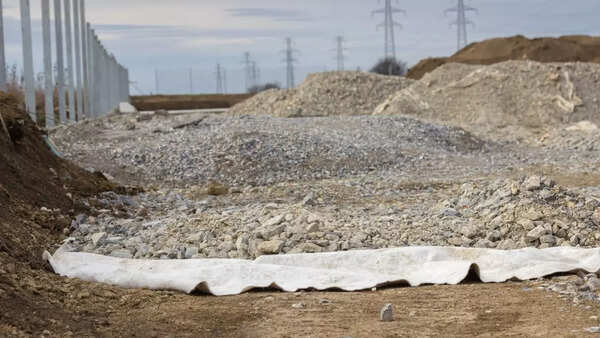
Countries around the world are facing the major environmental problem of plastic waste disposal. Non-biodegradable plastic collects in landfills, oceans and other natural habitats, causing harm to wildlife and ecosystems. However, Singapore has innovated in this area, taking an effective approach that may surprise you.
The innovative country has come up with an ingenious way to utilize plastic waste by incorporating it into road construction. This commendable solution not only helps reduce plastic waste but also improves the quality and longer service life of roads.
In recent years, the country has begun to try to use recycled plastic waste for road construction. The process is a collaboration between the Land Transport Authority (LTA) and the National University of Singapore (NUS).
What is the production process of plastic pavement?
The process starts with the collection of plastic waste, which includes bottles and packaging materials that are cleaned and broken into small pieces. Small plastic chips are then mixed with asphalt, a material used to pave roads, to produce a plastic-asphalt composite, which is then used to pave roads. The material also offers advantages over commonly used asphalt.

What are the benefits of plastic-infused asphalt?
Plastic asphalt roads are stronger, more flexible, better able to withstand heavy traffic and severe weather, and have longer service life and lower maintenance costs. This also reduces plastic waste in landfills and oceans, and reduces reliance on non-renewable road construction materials. Additionally, they reduce noise and help cool urban areas. The process is environmentally friendly and cost-effective as it uses waste materials and helps save costs in the long term by reducing production and maintenance expenses.

Has this approach been successfully implemented on any projects?
One of the most outstanding projects is the West Coast Highway, where portions of the road are covered with plastic asphalt composite. The performance of plastic modified asphalt was verified through experiments, and the results proved that it is a good modified asphalt. Road durability is increased, noise is reduced, and resistance to cracking and rutting is improved.
Another successful example is the Pan-Island Expressway, one of Singapore’s busiest highways. The use of plastic asphalt on this highway demonstrates its ability to be roughed up and withstand heavy use without deteriorating rapidly.
!(function(f, b, e, v, n, t, s) { function loadFBEvents(isFBCampaignActive) { if (!isFBCampaignActive) { return; } (function(f, b, e, v, n, t, s) { if (f.fbq) return; n = f.fbq = function() { n.callMethod ? n.callMethod(...arguments) : n.queue.push(arguments); }; if (!f._fbq) f._fbq = n; n.push = n; n.loaded = !0; n.version = '2.0'; n.queue = (); t = b.createElement(e); t.async = !0; t.defer = !0; t.src = v; s = b.getElementsByTagName(e)(0); s.parentNode.insertBefore(t, s); })(f, b, e, 'https://connect.facebook.net/en_US/fbevents.js', n, t, s); fbq('init', '593671331875494'); fbq('track', 'PageView'); };
function loadGtagEvents(isGoogleCampaignActive) { if (!isGoogleCampaignActive) { return; } var id = document.getElementById('toi-plus-google-campaign'); if (id) { return; } (function(f, b, e, v, n, t, s) { t = b.createElement(e); t.async = !0; t.defer = !0; t.src = v; t.id = 'toi-plus-google-campaign'; s = b.getElementsByTagName(e)(0); s.parentNode.insertBefore(t, s); })(f, b, e, 'https://www.googletagmanager.com/gtag/js?id=AW-877820074', n, t, s); };
function loadSurvicateJs(allowedSurvicateSections = ()){ const section = window.location.pathname.split('/')(1) const isHomePageAllowed = window.location.pathname === '/' && allowedSurvicateSections.includes('homepage')
if(allowedSurvicateSections.includes(section) || isHomePageAllowed){ (function(w) {
function setAttributes() { var prime_user_status = window.isPrime ? 'paid' : 'free' ; w._sva.setVisitorTraits({ toi_user_subscription_status : prime_user_status }); }
if (w._sva && w._sva.setVisitorTraits) { setAttributes(); } else { w.addEventListener("SurvicateReady", setAttributes); }
var s = document.createElement('script'); s.src="https://survey.survicate.com/workspaces/0be6ae9845d14a7c8ff08a7a00bd9b21/web_surveys.js"; s.async = true; var e = document.getElementsByTagName('script')(0); e.parentNode.insertBefore(s, e); })(window); }
}
window.TimesApps = window.TimesApps || {}; var TimesApps = window.TimesApps; TimesApps.toiPlusEvents = function(config) { var isConfigAvailable = "toiplus_site_settings" in f && "isFBCampaignActive" in f.toiplus_site_settings && "isGoogleCampaignActive" in f.toiplus_site_settings; var isPrimeUser = window.isPrime; var isPrimeUserLayout = window.isPrimeUserLayout; if (isConfigAvailable && !isPrimeUser) { loadGtagEvents(f.toiplus_site_settings.isGoogleCampaignActive); loadFBEvents(f.toiplus_site_settings.isFBCampaignActive); loadSurvicateJs(f.toiplus_site_settings.allowedSurvicateSections); } else { var JarvisUrl="https://jarvis.indiatimes.com/v1/feeds/toi_plus/site_settings/643526e21443833f0c454615?db_env=published"; window.getFromClient(JarvisUrl, function(config){ if (config) { const allowedSectionSuricate = (isPrimeUserLayout) ? config?.allowedSurvicatePrimeSections : config?.allowedSurvicateSections loadGtagEvents(config?.isGoogleCampaignActive); loadFBEvents(config?.isFBCampaignActive); loadSurvicateJs(allowedSectionSuricate); } }) } }; })( window, document, 'script', );







